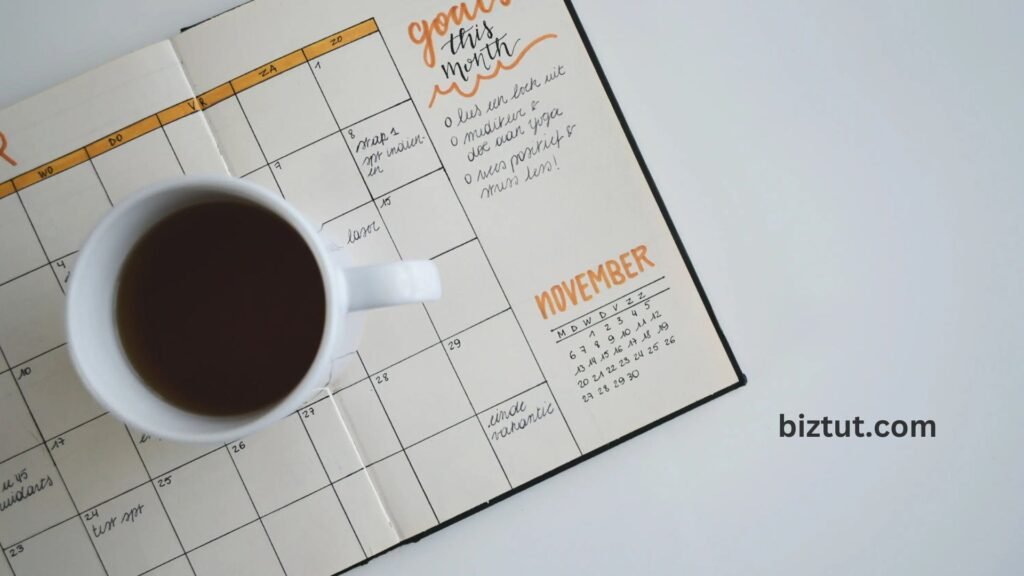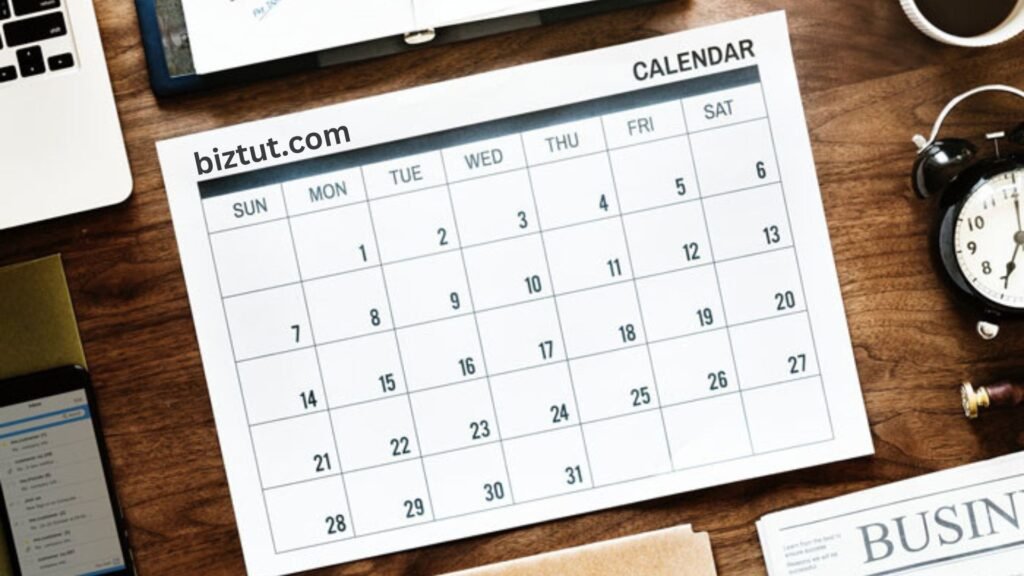Managing a social media account—or even several—isn’t easy. With new posts to create, audience interactions to handle, and company promotions to share, it can feel like you’re juggling a lot just to keep everything running smoothly. But there’s a simpler way to do it.
Think of a social media content calendar as your handy cheat sheet. It lets you plan your posts ahead of time, so you can maintain a steady flow of high-quality content without the stress. Whether you want to plan for 30 days or even a whole year, a content calendar helps you keep your messaging consistent and your audience engaged.
Feeling unsure if it can work for you? Check out our simple six-step guide to learn more about social media content calendars and how to create your own!
What is a social media content calendar?
At its core, a social media content calendar is just a calendar that lists all your social media posts. By making one, you’re creating a go-to resource where you can plan future posts, keep track of what you’ve shared, and work together with different teams.
This type of calendar is super helpful, especially if you’re juggling several social media accounts like Instagram, Facebook, LinkedIn, TikTok, Twitter, and more. A content calendar allows you to post with a consistent voice, manage different versions of each post, and decide what to share on each account.
Do I really need a social media content calendar?
Maybe you’re currently planning all your posts directly in your social media apps as you go. You might be wondering: Do I really need a calendar? The answer is yes! A content calendar is essential for any social media marketing team. With one, you can:

- Plan posts ahead of time. Get ahead by visualizing what’s coming up in your content strategy.
- Brainstorm social posts. Collaborate with team members to come up with new ideas and bring fresh voices to your social media presence.
- Balance evergreen and timely content. Mix in both types of posts—those that are always relevant and those that are timely—to keep your audience engaged.
- Track important upcoming dates. Note significant company events, like product launches, so you can prepare content in advance.
- Stay updated on hashtags. Keep a list of relevant and trending hashtags to use based on your post’s content.
- Schedule influencer posts. If you’re collaborating with industry leaders, keep track of their contributions and your engagement all in one place.
- Collect visual assets. Plan your visuals in advance to make your posts more eye-catching.
- Report on social media metrics. Monitor how your posts perform and keep track of engagement metrics to help you meet your goals.
To create an effective social media content calendar, you’ll need a tool that helps you organize and visualize your posts. If you’re just starting out, try a work management tool that offers a free content calendar template, like Asana. Our template will help you get going with example tasks and sections, and you can view your calendar in Calendar View to see how your previous posts performed.
How to create a social media content calendar
Alright, you’re ready to get started! But how do you actually build your calendar? We suggest using a work management tool like Asana and checking out our free social media content calendar. This tool lets you track your processes, look back at past posting schedules, keep everything visible, and stay in sync with your team.

No matter where you decide to build your calendar, follow these six steps to get rolling:
1. Identify Your Social Media Channels
This might sound obvious, but it’s one of the most crucial steps to improve your social media posting schedule and marketing campaigns. Before you dive into individual posts and strategies for each channel, take a moment with your team to figure out: Which social media platforms should we focus on?
Think about different formats like feed posts, stories, reels, polls, ads, or shoppable posts to see where you can make the biggest impact. Is there a platform that your audience doesn’t use much? Or maybe there’s a popular one you haven’t started building yet? Don’t forget about any old accounts that might have been left behind.
By figuring out where your audience is most active, you can concentrate on those platforms and create content that really connects, whether it’s a poll on one channel or a live stream on another.
2. Conduct an Audit of Your Social Platforms
One great thing about having a social media content calendar is that it helps you track your progress. So, it’s smart to have a baseline to start from. When you audit your current social profiles, make note of:
- Your best-performing post on each channel.
- What types of posts get the most engagement.
- When your audience is most active.
- How different types of posts perform (like comparing image posts to video content, or blog posts to external shares).
- The popularity of evergreen vs. timely content.
- Your audience demographics on each platform.
- The current status of each social platform.
If your audit shows you’re not quite sure what’s working, that’s okay! Your calendar will help you report and track data, so you can keep improving as you go.
3. Decide What You Want to Track
Now that you know which channels to focus on and how your posts are currently doing, it’s time to create your social media content calendar. If you started with our free template, you already have a good foundation for tracking the basics. To enhance it, consider using metadata in your calendar tool to keep track of extra details, like which hashtags you’re using, the channels you’re posting on, when the posts will go live, your target audience, relevant @-mentions, and more.
4. Plan Your Posting Schedule
As you set up your posts, decide how often you want to post and how far in advance you’ll write them. Knowing your posting schedule helps you manage your workload and optimize your content creation process.
If you haven’t done so yet, this is also a good time to build your asset library. If you often share images and videos, think about where those visuals come from. If you have a design team, planning ahead can help you avoid overwhelming them with requests. Or, if you use stock footage, having an asset library makes it easier to find images and videos.
5. Create a Review Schedule
Take some time to discuss and agree on a review schedule with your social team. Who needs to check the posts, and when? Do you need any approvals from your brand or legal teams? Your social calendar is there to help you establish these processes and keep track of content reviews in one central spot.
6. Track and Report on Published Content
With your calendar tracking your posts, you now have a central place for all your past content. Use this opportunity to look back at trends and add social media analytics data to your earlier posts—like how many likes and impressions a post received in the first hour. Were there any standout engagement metrics? This is a chance to see what works and continue refining your social media campaigns!
Social media content calendar example
Every social media content calendar is a bit different because it depends on the channels your team uses, how often you post, what information you want to track, and which workflows matter most to you. Here’s a quick example of what a typical social media content calendar might look like:

Think of this as a starting point to create your own calendar. You can fill it with the types of content that fit your needs, add your social networks, and use it to keep track of your social media marketing strategy.
The benefits of a social media content calendar
Creating and managing a social media content calendar can open up new possibilities for your team. With a calendar, you can bring strategy and metrics into your planning, making your social accounts more lively and engaging. Here are some ways a social media content calendar can help you:
Keep a Consistent Posting Schedule
Without a central calendar, it’s tough to see when you’re posting on each account. A calendar lets you track all your upcoming and past posts, ensuring each account gets the attention it deserves. Plus, by planning your posts in advance, you can avoid gaps in coverage and fill those spots with new content if needed.
Get the Timing Right for Every Post
Each social post takes a lot of effort and thought. But without a good plan, your posts can easily get lost in the feed, and your audience might miss the amazing content you created for them. A social calendar helps you organize your posts and plan the best times to share them, so they grab your audience’s attention.
Centralize Your Content Planning
Depending on what you’re posting, you might need images, blog links, videos, or customer quotes. A social media content calendar helps you figure out what you need and source materials from your marketing team, keeping everything organized and attached to the right posts.
Avoid Big Mistakes
Make sure everything you post is polished and error-free. With a calendar, you can review all upcoming posts to catch any spelling mistakes, ensure you’re using the right links and images, and prevent major blunders before they happen.
Increase Cross-Functional Visibility
Not everyone on your team has access to your social media planning tool, which can make it hard for them to know what you’re posting and when. A social media content calendar that everyone can access makes it easier for team members to re-share, like, and amplify your posts. This way, you’re not just keeping track of your content for yourself; you’re also providing a helpful resource for your teammates.
Get Started with Social Media Analytics
To improve your social media strategy, you need to review what you’ve done in the past. What worked well? What didn’t? Which posts got the most engagement? Instead of sifting through individual posts on Instagram or LinkedIn, find a tool that helps you look back on your past posts easily.
Common mistakes to avoid when using a social media content calendar
Creating a solid social media content calendar can really help streamline your digital marketing efforts. But there are some common traps that can hold back your social media plans. By being aware of these mistakes, you can make your calendar more effective and impactful.

Not Considering Platform Differences
Each social media platform has its own audience and preferred content types. One big mistake is treating all platforms the same. Make sure to tailor your content to fit the specific audience and format of each platform.
Ignoring Analytics
Data is crucial for improving your social media strategy. If you don’t pay attention to the insights from your analytics tools, you might miss out on chances to make your content more engaging. Take the time to review your analytics regularly to see what works and what doesn’t.
Being Too Rigid
While sticking to your calendar is important, being too strict can hurt you. Social media is always changing, and sometimes you need to adapt quickly to trends or current events. Your content calendar should have some flexibility so you can include spontaneous posts when needed.
Not Engaging with Your Audience
Posting content is only part of the social media game. If you don’t interact with your audience through comments, likes, and shares, your brand might come off as distant. Make sure to schedule time for engagement to build a stronger connection with your audience.
By steering clear of these common pitfalls, your social media content calendar can become a powerful tool for managing your online presence. Remember, the goal is to create a balanced, insightful, and adaptable schedule that resonates with your audience and strengthens your brand’s digital footprint.

Also Read: Creating an Email Campaign: Quick Steps & Examples
How do I come up with new content ideas?
Figuring out what to post on social media can be a bit of a challenge—that’s why your team has put you in charge as the social media manager. It’s your job to share timely content that your customers love and that your audience wants to engage with. And let me tell you, that’s not an easy task!
A social media content calendar can do more than just help you schedule your posts—it can also help you plan them out. For example, if you’re managing a food-focused Instagram account and you find out that National Pancake Day is coming up, you can plan a post for that day well in advance. This gives you plenty of time to be creative, proofread your copy, and find the perfect images, instead of rushing to post something last minute when you see your competitors talking about pancakes.
Plus, your content calendar makes it super easy to look back at past posts and see what’s been working. So if you’re ever unsure about what to post, don’t worry! Your calendar can guide you on what your audience enjoys, allowing you to craft messages that align with your best-performing content.




